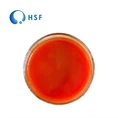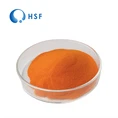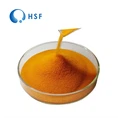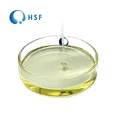Carotenoids Overview
Carotenoids are a group of important natural pigments. They can be divided into two categories based on their chemical structure. One category consists of carotenoids that only contain carbon and hydrogen, including β-carotene, α-carotene, lycopene, and others. The other category includes carotenoids which also contain oxygen in addition to carbon and hydrogen. Examples of these oxygen-containing derivatives of carotenoids are lutein, zeaxanthin, and cryptoxanthin.
Carotenoids such as β-carotene and α-carotene can serve as precursors of vitamin A. On the other hand, carotenoids like lutein, lycopene, and zeaxanthin do not have vitamin A activity. However, they have gained widespread attention in recent years due to their antioxidant properties, cardiovascular protective effects, and benefits for eye and skin health.

Structure and Properties of Lutein
The molecular formula of lutein is C40H56O2 and its molecular weight is 568.87. Lutein monomers have a molecular structure consisting of a long polyene chain with 40 carbon atoms, containing nine conjugated double bonds and four methyl groups. The two ends of the carbon chain are two different xanthophyll rings (one is a β-xanthophyll ring, and the other is an ε-xanthophyll ring). Lutein molecules have three chiral carbon atoms, so theoretically there can be eight enantiomers. In addition, lutein has multiple carbon-carbon double bonds, theoretically each of which can have cis and trans isomers, so lutein can exist in a large number of cis-trans isomers, among which all-trans isomers are the most common. The unsaturation of the lutein molecular structure makes it relatively unstable and not resistant to light, heat, and oxygen.
Lutein in the human body: digestion, absorption, metabolism, and bioavailability
1. Digestion, Absorption, and Metabolism
After food is digested in the stomach, lutein is released and forms lipid micelles by combining with other lipids. Upon entering the small intestine, these lipid micelles undergo emulsification with the help of bile, forming mixed micelles. The transfer of lutein into mixed micelles is influenced by various factors, including its molecular structure, pH value, lipid concentration in bile, and dietary fat content. A small amount of lutein may also enter protein or lipid structures such as liposomes and vesicles.
Mixed micelles and liposomes are taken up by passive diffusion and lipid transporters on the intestinal epithelial cell membrane, such as SR-BI, CD36, and NPC1L1, and enter the enterocytes of the duodenum. Lutein is then incorporated into chylomicrons and transported into the bloodstream via the portal vein or through the lymphatic system. In the bloodstream, lutein binds to plasma lipoproteins and is subsequently transported and stored in various tissues.
Carotenoids with low polarity, such as β-carotene, mainly bind to low-density lipoproteins (LDL), while lutein and zeaxanthin, which have higher polarity, primarily bind to high-density lipoproteins (HDL). Additionally, certain proteins, such as carotenoid-binding proteins like steroidogenic acute regulatory protein, albumin, and lactoglobulin, participate in the transport of lutein. However, the binding capacity of albumin and lactoglobulin is relatively weak.

2. The bioavailability of lutein can be influenced by various factors, including the nature and texture of the food, cooking and processing methods, fat intake, and interactions with other nutrients, as well as host-related factors such as age, gender, and genetic variations.
Minerals can potentially affect the bioavailability of lutein. For example, calcium and magnesium can inhibit the formation of mixed micelles, while sodium ions can interfere with the formation of mixed micelles containing lutein. Heat, pressure, or enzymatic treatment can improve the release of lutein from the food matrix, thereby increasing its bioavailability.
Moderate amounts of dietary fat are beneficial for the digestion and absorption of lutein. Various carotenoids and other fat-soluble components may interact or compete with lutein during the absorption process. For instance, there may be competition between lutein and β-carotene absorption when consuming supplements or vegetables. However, when infants consume formula milk, lutein appears to enhance the absorption of β-carotene.

The main biological functions of lutein are as follows
1. Constituting macular pigments and protecting against blue light and oxidative damage. Lutein is characteristic of its distribution and accumulation in the eye, particularly in the macula, where it effectively absorbs and filters high-energy blue light, protecting the eyes from damage caused by blue light. Lutein also acts as an antioxidant, quenching singlet oxygen and capturing oxygen free radicals, thereby preventing damage to cells and tissues caused by oxidative stress.
2. Improving neurological functions
Studies have shown that lutein can enhance intercellular communication between glial cells and neurons in the nervous system by improving gap junction communication. There is also evidence suggesting that the concentration of lutein in the retina serves as a marker for lutein concentration in the brain, which can enhance the functionality of the visual motor system and improve overall cognition, language learning ability, and executive function in humans.

The physiological functions of lutein in infants and premature infants
The period from 0 to 6 months is a critical period for the development of infant eyes, and infants' eyes are more susceptible to damage from blue light. Additionally, the blood flow control ability in the retina of infants is not fully developed, and excessive oxygen delivery to the retina can lead to oxidative stress and damage to the retina. The macula in the retina is a crucial area for receiving visual stimuli. As the main pigment in the macula, lutein can protect the optic nerve against damage from blue light and oxidative stress, promoting the healthy development of the eyes in infants.

The current status of lutein application in infant formula
For infants who are exclusively breastfed, breast milk is the only source of lutein. However, in some special situations where exclusive breastfeeding is not possible, it is important to ensure that the ingredients in infant formula are as similar to breast milk as possible. Studies have shown that infants fed formula without lutein have significantly lower levels of lutein in their bodies compared to breastfed infants. It is estimated that the amount of lutein added to infant formula needs to be four times higher than the level in breast milk to achieve the same level of lutein in the plasma of formula-fed infants. To ensure that infants fed with formula also receive adequate amounts of lutein, many countries and regions allow the addition of lutein to infant and toddler formula.
However, to date, there is very little data on the levels or amounts of lutein added to infant formula in China. The physiological functions of lutein in infants and the necessity of adding it to the formula have not received sufficient attention, so only a few brands have introduced infant formulas with added lutein in the market. The stability of lutein added to the formula is influenced by several factors, such as processing technology, processing temperature, the nature of the lutein raw material itself, the influence of other components in the formula, and storage time and temperature.

HSF Biotech Produce Lutein/Lutein Ester: A Vital Component in Infant Formula
HSF Biotech is a leading manufacturer of nutritional supplements, and one of their most popular products is Lutein/Lutein Ester. This supplement comes in various specifications and is widely used in infant formulas due to its numerous health benefits for young children.
Lutein/Lutein Ester has the ability to enhance visual development, support the immune system, protect the brain, and improve skin health making it an essential nutrient for young children. By incorporating this supplement into their formulas, HSF Biotech ensures that infants receive the necessary nutrients for optimal growth and development, contributing to their overall well-being.
Want to get FREE SAMPLES, please contact our specialists at sales@healthfulbio.com.





